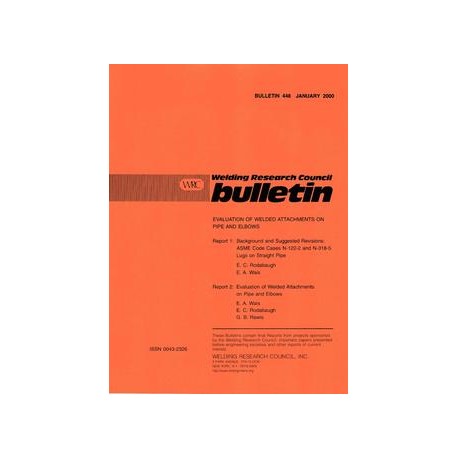Product successfully added to your shopping cart
Quantity
Total
There are 5 items in your cart. There is 1 item in your cart.
Total products $127.60
Total shipping To be determined
Total $127.60
New Reduced price!  View larger
View larger
 View larger
View larger WRC 448
M00000585
New product
WRC 448 Part 1: Evaluation of Welded Attachments on Pipe and Elbows: Background & Suggested Revisions ASME Code Cases N-122-2 and N-318-5 Lugs on Straight Pipe; Part 2: Evaluation of Welded Attachments on Pipe and Elbows: Evaluation of Welded Attachments on Pipe and Elbows
Bulletin / Circular by Welding Research Council, 2000
E. C. Rodabaugh, E. A. Wais; E. A. Wais, E. C. Rodabaugh, G.B. Rawls
In stock
More info
Full Description
Part 1: Evaluation of Welded Attachments on Pipe and Elbows: Background some four years after the publication of Welding Research Council Bulletin 198. The motivation of the development of N-122 is described by the following extract from WRC 198."A piping system design requires the specification of a corresponding support system whose function is to transmit forces to the piping system or to limit its deformation. Structural attachments which connect the pipe system with its supporting elements are classified into two general categories, those integral to the piping system and those that are not. Lugs welded to the pipe are examples of integral attachments, whereas roller supports and various types of clamps are examples of nonintegral attachments. Article NB-3645 of Section III of the ASME Boiler and Pressure Vessel Code requires that the effects of attachments in producing thermal stresses, stress concentrations, and restraints on pressure-retaining members shall be taken into account in checking for compliance with design criteria."
The preceding quote is directly relevant to N-122 (Class 1 piping); WRC 198 covered only Class 1 piping. However, having a relatively simple method of calculating stresses at lugs, the analogous N-318, for Class 2 and 3 piping, was developed.
During the years between 1980 and 1994, N-122-1, and N-318-1, -2, -3, -4, were published. These mostly involved clarifications of how to use the Cases. In 1994, N-122-2 and N-318-5 were published. These editions included a major change in that the coefficients of the equations for CT, CL and CN were divided by two. This report deals, in large part, with the bases for making this change.
The review of this report leads to several suggestions for revisions to N-122-2 and/or N-318-5. These are discussed in Sections 4.3, 4.4 and 4.5 of this report and are summarized in Section 8.
Part 2: Evaluation of Welded Attachments on Pipe and Elbows: Evaluation of Welded Attachments on Pipe and Elbows
Although lugs are often used on straight pipe and elbows, until recently there was very little data available regarding the fatigue life and limit load characteristics of these attachments. This report describes the results of a testing program of welded lug-on-pipe and lug-on-elbow configurations. The purpose of the testing was to gather data to develop an evaluation methodology for various lug-on-pipe/elbow attachments. Many of these configurations are not specifically covered by any of the ASME or ANSI piping codes. This study was limited to lugs on straight pipe and extrados (outside surface of the bend) of elbows. Lugs on the sides, intrados (inside surface of the bend), or elsewhere on elbows are not covered.
The fatigue tests are evaluated in terms of Stress Intensification Factors (SIFs), or i-factors for Class 2/3 piping and in terms of C and K indices for Class 1 piping. The limit load tests are evaluated in terms of B indices. Code Case N-318-5 is used as a basis of evaluation. Code Case N-318-5 is included herein as Appendix E.
Reference 2 and 3 provide a summary of the results of the testing program and the general conclusions. The purpose of this report is to document, in detail, test specimens data, test methodology, test results and the methodology used in the analysis of the data. A general analysis methodology is suggested which covers the lug configurations tested, and other similar designs.


